Which Statement Is Not True About Invertebrate Animals?
| Invertebrates Temporal range: Cryogenian to Present, | |
|---|---|
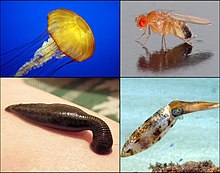 | |
| Examples of invertebrates from different phyla; clockwise from peak-left: Chrysaora fuscescens (a cnidarian), Drosophila melanogaster (an arthropod), Caribbean reef squid (a mollusk), and Hirudo medicinalis (an annelid). | |
| Scientific nomenclature | |
| (unranked): | Filozoa |
| Kingdom: | Animalia |
| Groups included | |
| |
Invertebrates are species of animal that neither possess nor develop a vertebral column (ordinarily known every bit a backbone or spine), derived from the notochord. This includes all animals apart from the chordate subphylum Vertebrata. Familiar examples of invertebrates include arthropods (insects, arachnids, crustaceans, and myriapods), mollusks (chitons, snails, bivalves, and cephalopods), annelid (earthworms and leeches), and cnidarians (hydras, jellyfishes, sea anemones, and corals).
The bulk of animal species are invertebrates; i estimate puts the figure at 97%.[1] Many invertebrate taxa have a greater number and variety of species than the unabridged subphylum of Vertebrata.[2] Invertebrates vary widely in size, from 50 μm (0.002 in) rotifers[3] to the 9–x m (30–33 ft) colossal squid.[4]
Some and so-called invertebrates, such as the Tunicata and Cephalochordata, are more than closely related to vertebrates than to other invertebrates. This makes the invertebrates paraphyletic, so the term has petty meaning in taxonomy.
Etymology
The word "invertebrate" comes from the Latin discussion vertebra, which means a joint in general, and sometimes specifically a joint from the spinal cavalcade of a vertebrate. The jointed aspect of vertebra is derived from the concept of turning, expressed in the root verto or vorto, to turn.[five] The prefix in- means "not" or "without".[half dozen]
Taxonomic significance
The term invertebrates is not always precise among not-biologists since it does non accurately describe a taxon in the same fashion that Arthropoda, Vertebrata or Manidae do. Each of these terms describes a valid taxon, phylum, subphylum or family. "Invertebrata" is a term of convenience, non a taxon; it has very little circumscriptional significance except within the Chordata. The Vertebrata every bit a subphylum comprises such a pocket-sized proportion of the Metazoa that to speak of the kingdom Animalia in terms of "Vertebrata" and "Invertebrata" has express practicality. In the more than formal taxonomy of Animalia other attributes that logically should precede the presence or absenteeism of the vertebral column in amalgam a cladogram, for example, the presence of a notochord. That would at least circumscribe the Chordata. However, even the notochord would be a less primal criterion than aspects of embryological development and symmetry[7] or possibly bauplan.[8]
Despite this, the concept of invertebrates every bit a taxon of animals has persisted for over a century amid the laity,[9] and within the zoological community and in its literature it remains in use as a term of convenience for animals that are non members of the Vertebrata.[10] The following text reflects before scientific agreement of the term and of those animals which accept constituted it. Co-ordinate to this understanding, invertebrates do non possess a skeleton of os, either internal or external. They include hugely varied body plans. Many have fluid-filled, hydrostatic skeletons, like jellyfish or worms. Others have difficult exoskeletons, outer shells similar those of insects and crustaceans. The nearly familiar invertebrates include the Protozoa, Porifera, Coelenterata, Platyhelminthes, Nematoda, Annelida, Echinodermata, Mollusca and Arthropoda. Arthropoda include insects, crustaceans and arachnids.
Number of extant species
Past far the largest number of described invertebrate species are insects. The following table lists the number of described extant species for major invertebrate groups as estimated in the IUCN Ruddy List of Threatened Species, 2014.3.[eleven]
| Invertebrate group | Latin name | Paradigm | Estimated number of described species[xi] |
|---|---|---|---|
| Insects | Insecta | 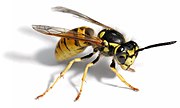 | 1,000,000 |
| Arachnids | Arachnida |  | 102,248 |
| Molluscs | Mollusca | 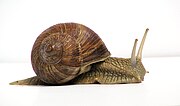 | 85,000 |
| Crustaceans | Crustacea | 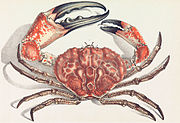 | 47,000 |
| Corals | Anthozoa |  | ii,175 |
| Velvet worms | Onychophora |  | 165 |
| Horseshoe crabs | Xiphosura |  | four |
| Others jellyfish, echinoderms, sponges, other worms etc. | — | — | 68,658 |
| Total: | ~1,300,000 |
The IUCN estimates that 66,178 extant vertebrate species take been described,[eleven] which means that over 95% of the described animal species in the world are invertebrates.
Characteristics
The trait that is common to all invertebrates is the absence of a vertebral cavalcade (courage): this creates a distinction between invertebrates and vertebrates. The distinction is 1 of convenience only; it is not based on any clear biologically homologous trait, any more than the common trait of having wings functionally unites insects, bats, and birds, or than not having wings unites tortoises, snails and sponges. Being animals, invertebrates are heterotrophs, and require sustenance in the form of the consumption of other organisms. With a few exceptions, such equally the Porifera, invertebrates generally have bodies composed of differentiated tissues. There is besides typically a digestive bedroom with one or two openings to the exterior.
Morphology and symmetry
The trunk plans of most multicellular organisms exhibit some form of symmetry, whether radial, bilateral, or spherical. A minority, yet, showroom no symmetry. One case of asymmetric invertebrates includes all gastropod species. This is easily seen in snails and sea snails, which have helical shells. Slugs appear externally symmetrical, but their pneumostome (breathing hole) is located on the correct side. Other gastropods develop external asymmetry, such as Glaucus atlanticus that develops asymmetrical cerata as they mature. The origin of gastropod asymmetry is a subject of scientific argue.[12]
Other examples of asymmetry are found in fiddler crabs and hermit crabs. They frequently accept one hook much larger than the other. If a male fiddler loses its big claw, it will grow another on the opposite side after moulting. Sessile animals such every bit sponges are asymmetrical[13] alongside coral colonies (with the exception of the individual polyps that exhibit radial symmetry); alpheidae claws that lack pincers; and some copepods, polyopisthocotyleans, and monogeneans which parasitize by attachment or residency inside the gill chamber of their fish hosts).
Nervous system
Neurons differ in invertebrates from mammalian cells. Invertebrates cells fire in response to similar stimuli equally mammals, such equally tissue trauma, loftier temperature, or changes in pH. The first invertebrate in which a neuron jail cell was identified was the medicinal leech, Hirudo medicinalis. [fourteen] [fifteen]
Learning and memory using nociceptors in the sea hare, Aplysia has been described.[16] [17] [18] Mollusk neurons are able to notice increasing pressures and tissue trauma.[19]
Neurons accept been identified in a wide range of invertebrate species, including annelids, molluscs, nematodes and arthropods.[20] [21]
Respiratory organization

Tracheal system of dissected cockroach. The largest tracheae run across the width of the trunk of the cockroach and are horizontal in this image. Scale bar, ii mm.
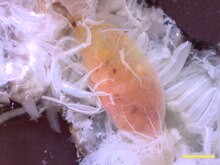
The tracheal organisation branches into progressively smaller tubes, here supplying the crop of the cockroach. Scale bar, two.0 mm.
One type of invertebrate respiratory system is the open respiratory system equanimous of spiracles, tracheae, and tracheoles that terrestrial arthropods accept to transport metabolic gases to and from tissues.[22] The distribution of spiracles can vary greatly among the many orders of insects, simply in general each segment of the body can have only 1 pair of spiracles, each of which connects to an atrium and has a relatively large tracheal tube behind it. The tracheae are invaginations of the cuticular exoskeleton that branch (anastomose) throughout the body with diameters from only a few micrometres upwardly to 0.eight mm. The smallest tubes, tracheoles, penetrate cells and serve as sites of diffusion for h2o, oxygen, and carbon dioxide. Gas may be conducted through the respiratory system by ways of active ventilation or passive diffusion. Different vertebrates, insects do not generally deport oxygen in their haemolymph.[23]
A tracheal tube may comprise ridge-like circumferential rings of taenidia in various geometries such as loops or helices. In the caput, thorax, or abdomen, tracheae may also exist connected to air sacs. Many insects, such equally grasshoppers and bees, which actively pump the air sacs in their abdomen, are able to command the flow of air through their body. In some aquatic insects, the tracheae substitution gas through the trunk wall directly, in the form of a gill, or part essentially as normal, via a plastron. Note that despite existence internal, the tracheae of arthropods are shed during moulting (ecdysis).[24]
Reproduction
Similar vertebrates, most invertebrates reproduce at least partly through sexual reproduction. They produce specialized reproductive cells that undergo meiosis to produce smaller, motile spermatozoa or larger, non-motile ova.[25] These fuse to form zygotes, which develop into new individuals.[26] Others are capable of asexual reproduction, or sometimes, both methods of reproduction.
Social beliefs is widespread in invertebrates, including cockroaches, termites, aphids, thrips, ants, bees, Passalidae, Acari, spiders, and more than.[27] Social interaction is particularly salient in eusocial species simply applies to other invertebrates equally well.
Insects recognize information transmitted past other insects.[28] [29] [30]
Phyla
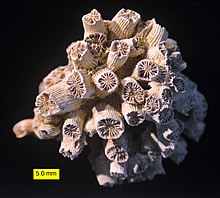
The term invertebrates covers several phyla. I of these are the sponges (Porifera). They were long idea to have diverged from other animals early.[31] They lack the complex organisation found in most other phyla.[32] Their cells are differentiated, simply in most cases not organized into distinct tissues.[33] Sponges typically feed by drawing in h2o through pores.[34] Some speculate that sponges are not then primitive, but may instead be secondarily simplified.[35] The Ctenophora and the Cnidaria, which includes body of water anemones, corals, and jellyfish, are radially symmetric and have digestive chambers with a single opening, which serves as both the mouth and the anus.[36] Both have distinct tissues, but they are not organized into organs.[37] At that place are simply two master germ layers, the ectoderm and endoderm, with only scattered cells between them. As such, they are sometimes called diploblastic.[38]
The Echinodermata are radially symmetric and exclusively marine, including starfish (Asteroidea), ocean urchins, (Echinoidea), breakable stars (Ophiuroidea), bounding main cucumbers (Holothuroidea) and feather stars (Crinoidea).[39]
The largest creature phylum is as well included within invertebrates: the Arthropoda, including insects, spiders, crabs, and their kin. All these organisms take a body divided into repeating segments, typically with paired appendages. In addition, they possess a hardened exoskeleton that is periodically shed during growth.[40] Ii smaller phyla, the Onychophora and Tardigrada, are close relatives of the arthropods and share these traits. The Nematoda or roundworms, are perhaps the 2d largest creature phylum, and are besides invertebrates. Roundworms are typically microscopic, and occur in nearly every environment where at that place is h2o.[41] A number are important parasites.[42] Smaller phyla related to them are the Kinorhyncha, Priapulida, and Loricifera. These groups have a reduced coelom, called a pseudocoelom. Other invertebrates include the Nemertea or ribbon worms, and the Sipuncula.
Another phylum is Platyhelminthes, the flatworms.[43] These were originally considered primitive, simply it at present appears they developed from more complex ancestors.[44] Flatworms are acoelomates, defective a trunk cavity, as are their closest relatives, the microscopic Gastrotricha.[45] The Rotifera or rotifers, are common in aqueous environments. Invertebrates also include the Acanthocephala or spiny-headed worms, the Gnathostomulida, Micrognathozoa, and the Cycliophora.[46]
As well included are two of the virtually successful animal phyla, the Mollusca and Annelida.[47] [48] The onetime, which is the second-largest creature phylum by number of described species, includes animals such equally snails, clams, and squids, and the latter comprises the segmented worms, such equally earthworms and leeches. These 2 groups have long been considered close relatives considering of the common presence of trochophore larvae, but the annelids were considered closer to the arthropods because they are both segmented.[49] Now, this is mostly considered convergent development, owing to many morphological and genetic differences between the 2 phyla.[fifty]
Among lesser phyla of invertebrates are the Hemichordata, or acorn worms,[51] and the Chaetognatha, or arrow worms. Other phyla include Acoelomorpha, Brachiopoda, Bryozoa, Entoprocta, Phoronida, and Xenoturbellida.
Classification of invertebrates
Invertebrates can be classified into several principal categories, some of which are taxonomically obsolescent or debatable, but however used as terms of convenience. Each however appears in its own article at the following links.[52]
- Sponges (Porifera)
- Comb jellies (Ctenophora)
- Medusozoans and corals (Cnidaria)
- Acoels (Xenacoelomorpha)
- Flatworms (Platyhelminthes)
- Bristleworms, earthworms and leeches (Annelida)
- Insects, springtails, crustaceans, myriapods, chelicerates (Arthropoda)
- Chitons, snails, slugs, bivalves, tusk shells, cephalopods (Mollusca)
- Roundworms or threadworms (Nematoda)
- Rotifers (Rotifera)
- Tardigrades (Tardigrada)
- Scalidophores (Scalidophora)
- Lophophorates (Lophophorata)
- Velvet worms (Onychophora)
- Pointer worms (Chaetognatha)
- Gordian worms or horsehair worms (Nematomorpha)
- Ribbon worms (Nemertea)
- Placozoa
- Loricifera
- Starfishes, sea urchins, body of water cucumbers, sea lilies and brittle stars (Echinodermata)
- Acorn worms, cephalodiscids and graptolites (Hemichordata)
- Lancelets (Amphioxiformes)
- Salps, pyrosomes, doliolids, larvaceans and bounding main squirts (Tunicata)
History
The primeval animate being fossils announced to be those of invertebrates. 665-one thousand thousand-year-former fossils in the Trezona Formation at Trezona Bore, Westward Fundamental Flinders, S Australia have been interpreted as being early sponges.[53] Some paleontologists advise that animals appeared much earlier, possibly as early equally 1 billion years ago[54] though they probably became multicellular in the Tonian. Trace fossils such as tracks and burrows found in the late Neoproterozoic era indicate the presence of triploblastic worms, roughly as large (virtually 5 mm wide) and complex every bit earthworms.[55]
Around 453 MYA, animals began diversifying, and many of the important groups of invertebrates diverged from i another. Fossils of invertebrates are found in various types of sediment from the Phanerozoic.[56] Fossils of invertebrates are commonly used in stratigraphy.[57]
Classification
Carl Linnaeus divided these animals into only two groups, the Insecta and the at present-obsolete Vermes (worms). Jean-Baptiste Lamarck, who was appointed to the position of "Curator of Insecta and Vermes" at the Muséum National d'Histoire Naturelle in 1793, both coined the term "invertebrate" to describe such animals and divided the original 2 groups into ten, by splitting Arachnida and Crustacea from the Linnean Insecta, and Mollusca, Annelida, Cirripedia, Radiata, Coelenterata and Infusoria from the Linnean Vermes. They are at present classified into over xxx phyla, from unproblematic organisms such equally sea sponges and flatworms to complex animals such as arthropods and molluscs.
Significance of the group
Invertebrates are animals without a vertebral column. This has led to the determination that invertebrates are a grouping that deviates from the normal, vertebrates. This has been said to be considering researchers in the past, such equally Lamarck, viewed vertebrates as a "standard": in Lamarck's theory of development, he believed that characteristics acquired through the evolutionary process involved non simply survival, but likewise progression toward a "higher form", to which humans and vertebrates were closer than invertebrates were. Although goal-directed evolution has been abandoned, the distinction of invertebrates and vertebrates persists to this day, fifty-fifty though the group has been noted to be "hardly natural or even very abrupt." Another reason cited for this continued distinction is that Lamarck created a precedent through his classifications which is now difficult to escape from. It is also possible that some humans believe that, they themselves being vertebrates, the group deserves more attending than invertebrates.[58] In any event, in the 1968 edition of Invertebrate Zoology, information technology is noted that "division of the Animal Kingdom into vertebrates and invertebrates is artificial and reflects man bias in favor of man'southward own relatives." The book likewise points out that the grouping lumps a vast number of species together, so that no one characteristic describes all invertebrates. In improver, some species included are only remotely related to one another, with some more related to vertebrates than other invertebrates (come across Paraphyly).[59]
In enquiry
For many centuries, invertebrates were neglected by biologists, in favor of big vertebrates and "useful" or charismatic species.[lx] Invertebrate biology was not a major bailiwick until the work of Linnaeus and Lamarck in the 18th century.[60] During the 20th century, invertebrate zoology became ane of the major fields of natural sciences, with prominent discoveries in the fields of medicine, genetics, palaeontology, and environmental.[sixty] The study of invertebrates has also benefited law enforcement, every bit arthropods, and specially insects, were discovered to be a source of data for forensic investigators.[xl]
2 of the well-nigh commonly studied model organisms nowadays are invertebrates: the fruit fly Drosophila melanogaster and the nematode Caenorhabditis elegans. They have long been the most intensively studied model organisms, and were among the starting time life-forms to exist genetically sequenced. This was facilitated past the severely reduced land of their genomes, but many genes, introns, and linkages have been lost. Analysis of the starlet sea anemone genome has emphasised the importance of sponges, placozoans, and choanoflagellates, also being sequenced, in explaining the inflow of 1500 ancestral genes unique to animals.[61] Invertebrates are also used by scientists in the field of aquatic biomonitoring to evaluate the effects of h2o pollution and climate change.[62]
Come across also
- Invertebrate zoology
- Invertebrate paleontology
- Marine invertebrates
- Pain in invertebrates
References
- ^ May, Robert M. (16 September 1988). "How Many Species Are In that location on Earth?". Scientific discipline. 241 (4872): 1441–1449. Bibcode:1988Sci...241.1441M. doi:10.1126/science.241.4872.1441. JSTOR 1702670. PMID 17790039. S2CID 34992724. Archived from the original on xv November 2016. Retrieved 17 June 2014.
- ^ Richards, O. W.; Davies, R.G. (1977). Imms' General Textbook of Entomology: Volume 1: Structure, Physiology and Development Volume two: Classification and Biology. Berlin: Springer. ISBN978-0-412-61390-6.
- ^ Howey, Richard L. (1999). "Welcome to the Wonderfully Weird World of Rotifers". Micscape Mag. Retrieved 19 February 2010.
- ^ Roper, C.F.E. & P. Jereb (2010). Family Cranchiidae. In: P. Jereb & C.F.E. Roper (eds.) Cephalopods of the world. An annotated and illustrated catalogue of species known to engagement. Volume ii. Myopsid and Oegopsid Squids. FAO Species Catalogue for Fishery Purposes No. 4, Vol. 2. FAO, Rome. pp. 148–178.
- ^ Tucker, T. Grand. (1931). A Concise Etymological Dictionary of Latin. Halle (Saale): Max Niemeyer Verlag.
- ^ Skeat, Walter William (1882). An etymological dictionary of the English language. Clarendon Printing. p. 301.
- ^ Pechenik, Jan (1996). Biology of the Invertebrates. Dubuque: Wm. C. Dark-brown Publishers. ISBN978-0-697-13712-eight.
- ^ Brusca, Richard C.; Brusca, Gary J. (1990). Invertebrates . Sunderland: Sinauer Associates. ISBN978-0-87893-098-2.
- ^ Chocolate-brown, Lesley (1993). The New shorter Oxford English language dictionary on historical principles. Oxford [Eng.]: Clarendon. ISBN978-0-19-861271-1.
- ^ Louis Agassiz (21 March 2013). Essay on Classification. Courier Corporation. pp. 115–. ISBN978-0-486-15135-9.
- ^ a b c The World Conservation Union. 2014. IUCN Red List of Threatened Species, 2014.3. Summary Statistics for Globally Threatened Species. Table 1: Numbers of threatened species by major groups of organisms (1996–2014).
- ^ Louise R. Folio (2006). "Modern insights on gastropod development: Reevaluation of the evolution of a novel torso programme". Integrative and Comparative Biology. 46 (2): 134–143. doi:10.1093/icb/icj018. PMID 21672730.
- ^ Symmetry, biological, cited at FactMonster.com from The Columbia Electronic Encyclopedia (2007).
- ^ Nicholls, J.G. and Baylor, D.A., (1968). Specific modalities and receptive fields of sensory neurons in CNS of the leech. Journal of Neurophysiology, 31: 740–756
- ^ Pastor, J., Soria, B. and Belmonte, C., (1996). Properties of the nociceptive neurons of the leech segmental ganglion. Journal of Neurophysiology, 75: 2268–2279
- ^ Byrne, J.H., Castellucci, V.F. and Kandel, E.R., (1978). Contribution of individual mechanoreceptor sensory neurons to defensive gill-withdrawal reflex in Aplysia. Journal of Neurophysiology, 41: 418–431
- ^ Castellucci, V., Pinsker, H., Kupfermann, I. and Kandel, E.R., (1970). Neuronal mechanisms of habituation and dishabituation of the gill-withdrawal reflex in Aplysia. Scientific discipline, 167: 1745–1748
- ^ Fischer, T.M., Jacobson, D.A., Counsell, A.N., et al., (2011). Regulation of low-threshold afferent action may contribute to short-term habituation in Aplysia californica. Neurobiology of Learning and Memory, 95: 248-259
- ^ Illich, P.A and Walters, E.T., (1997). Mechanosensory neurons innervating Aplysia siphon encode noxious stimuli and display nociceptive sensitization. The Journal of Neuroscience, 17: 459-469
- ^ Eisemann, C.H., Jorgensen, W.K., Merritt, D.J., Rice, 1000.J., Cribb, B.W., Webb, P.D. and Zalucki, Thousand.P., (1984). "Do insects experience hurting? — A biological view". Cellular and Molecular Life Sciences, 40: 1420–1423
- ^ St John Smith, E. and Lewin, G.R., (2009). Nociceptors: a phylogenetic view. Periodical of Comparative Physiology A, 195: 1089-1106
- ^ Wasserthal, Lutz T. (1998). Affiliate 25: The Open Hemolymph Arrangement of Holometabola and Its Relation to the Tracheal Space. In "Microscopic Anatomy of Invertebrates". Wiley-Liss, Inc. ISBN 0-471-15955-seven.
- ^ Westneat, Mark W.; Betz, Oliver; Hulk, Richard W.; Fezzaa, Kamel; Cooper, James W.; Lee, Wah-Keat (January 2003). "Tracheal Respiration in Insects Visualized with Synchrotron 10-ray Imaging". Science. 299 (5606): 558–560. Bibcode:2003Sci...299..558W. doi:10.1126/science.1078008. PMID 12543973. S2CID 43634044. [ permanent expressionless link ]
- ^ Ewer, John (11 October 2005). "How the Ecdysozoan Changed Its Coat". PLOS Biology. 3 (x): e349. doi:x.1371/journal.pbio.0030349. ISSN 1545-7885. PMC1250302. PMID 16207077.
- ^ Schwartz, Jill (2010). Master the GED 2011 (w/CD). Peterson'southward. p. 371. ISBN978-0-7689-2885-3.
- ^ Hamilton, Matthew B. (2009). Population genetics . Wiley-Blackwell. p. 55. ISBN978-i-4051-3277-0.
- ^ The Evolution of Social Behavior in Insects and Arachnids. Cambridge Academy Press. 1997. ISBN978-0521589772.
- ^
- ^ Seeley T.D.; Visscher P.Yard.; Passino K.M. (2006). "Group determination making in honey bee swarms". American Scientist. 94 (iii): 220–229. doi:10.1511/2006.three.220.
- ^ Frisch, Karl von. (1967) The Dance Language and Orientation of Bees. Cambridge, Massachusetts: The Belknap Press of Harvard University Press.
- ^ Bhamrah, H. S.; Kavita Juneja (2003). An Introduction to Porifera. Anmol Publications PVT. LTD. p. 58. ISBN978-81-261-0675-two.
- ^ Sumich, James L. (2008). Laboratory and Field Investigations in Marine Life. Jones & Bartlett Learning. p. 67. ISBN978-0-7637-5730-4.
- ^ Jessop, Nancy Meyer (1970). Biosphere; a written report of life. Prentice-Hall. p. 428.
- ^ Sharma, N. S. (2005). Continuity And Evolution Of Animals. Mittal Publications. p. 106. ISBN978-81-8293-018-vi.
- ^ Dunn et al. 2008. "Wide phylogenomic sampling improves resolution of the brute tree of life". Nature 06614.
- ^ Langstroth, Lovell; Libby Langstroth; Todd Newberry; Monterey Bay Aquarium (2000). A living bay: the underwater earth of Monterey Bay. Academy of California Press. p. 244. ISBN978-0-520-22149-ix.
- ^ Safra, Jacob Due east. (2003). The New Encyclopædia Britannica, Volume 16. Encyclopædia Britannica. p. 523. ISBN978-0-85229-961-6.
- ^ Kotpal, R. 50. (2012). Modern Text Book of Zoology: Invertebrates. Rastogi Publications. p. 184. ISBN978-81-7133-903-vii.
- ^ Alcamo, Edward (1998). Biology Coloring Workbook. The Princeton Review. p. 220. ISBN978-0-679-77884-4.
- ^ a b Gunn, Alan (2009). Essential forensic biology. John Wiley and Sons. p. 214. ISBN978-0-470-75804-v.
- ^ Prewitt, Nancy L.; Larry S. Underwood; William Surver (2003). BioInquiry: making connections in biological science. John Wiley. p. 289. ISBN978-0-471-20228-8.
- ^ Schmid-Hempel, Paul (1998). Parasites in social insects. Princeton University Press. p. 75. ISBN978-0-691-05924-2.
- ^ Gilson, Étienne (2004). El espíritu de la filosofía medieval. Ediciones Rialp. p. 384. ISBN978-84-321-3492-0.
- ^ Ruiz-Trillo, Iñaki; Riutort, Marta; Littlewood, D. Timothy J.; Herniou, Elisabeth A.; Baguñà, Jaume (March 1999). "Acoel Flatworms: Earliest Extant Bilaterian Metazoans, Not Members of Platyhelminthes". Science. 283 (5409): 1919–1923. Bibcode:1999Sci...283.1919R. doi:ten.1126/science.283.5409.1919. ISSN 0036-8075. PMID 10082465. S2CID 6079655. [ permanent dead link ]
- ^ Todaro, Antonio. "Gastrotricha: Overview". Gastrotricha: Earth Portal. University of Modena & Reggio Emilia. Retrieved 26 January 2008.
- ^ Kristensen, Reinhardt Møbjerg (July 2002). "An Introduction to Loricifera, Cycliophora, and Micrognathozoa". Integrative and Comparative Biological science. 42 (3): 641–651. doi:10.1093/icb/42.3.641. PMID 21708760.
- ^ "Biodiversity: Mollusca". The Scottish Association for Marine Science. Archived from the original on 8 July 2006. Retrieved 19 November 2007.
- ^ Russell, Bruce J. (Writer), Denning, David (Writer) (2000). Branches on the Tree of Life: Annelids (VHS). BioMEDIA ASSOCIATES.
- ^ Eernisse, Douglas J.; Albert, James S.; Anderson, Frank Eastward. (i September 1992). "Annelida and Arthropoda are non sister taxa: A phylogenetic analysis of spiralean metazoan morphology". Systematic Biology. 41 (3): 305–330. doi:10.2307/2992569. ISSN 1063-5157. JSTOR 2992569.
- ^ Eernisse, Douglas J.; Kim, Chang Bae; Moon, Seung Yeo; Gelder, Stuart R.; Kim, Won (September 1996). "Phylogenetic Relationships of Annelids, Molluscs, and Arthropods Evidenced from Molecules and Morphology". Journal of Molecular Development. 43 (3): 207–215. Bibcode:1996JMolE..43..207K. doi:10.1007/PL00006079. PMID 8703086. [ dead link ]
- ^ Tobin, Allan J.; Jennie Dusheck (2005). Request well-nigh life. Cengage Learning. p. 497. ISBN978-0-534-40653-0.
- ^ "What Are the Principal Groups of Invertebrates?".
- ^ Maloof, Adam C.; Rose, Catherine V.; Beach, Robert; Samuels, Bradley M.; Calmet, Claire C.; Erwin, Douglas H.; Poirier, Gerald R.; Yao, Nan; Simons, Frederik J. (17 August 2010). "Possible beast-body fossils in pre-Marinoan limestones from S Australia". Nature Geoscience. 3 (9): 653. Bibcode:2010NatGe...3..653M. doi:10.1038/ngeo934.
- ^ Campbell. Neil A.; Jane B. Reece (2005). Biology (7 ed.). Pearson, Benjamin Cummings. p. 526. ISBN978-0-8053-7171-0.
- ^ Seilacher, A.; Bose, P.K.; Pflüger, F. (October 1998). "Animals More Than one Billion Years Ago: Trace Fossil Evidence from India". Scientific discipline. 282 (5386): 80–83. Bibcode:1998Sci...282...80S. doi:ten.1126/scientific discipline.282.5386.80. ISSN 0036-8075. PMID 9756480.
- ^ Clarkson, Euan Neilson Kerr (1998). Invertebrate palaeontology and evolution. Wiley-Blackwell. ISBN978-0-632-05238-seven.
- ^ Kummel, Bernhard (1954). Condition of invertebrate paleontology, 1953. Ayer Publishing. p. 93. ISBN978-0-405-12715-1.
- ^ Barnes, Richard Stephen Kent (2001). The Invertebrates: A Synthesis. Wiley-Blackwell. p. 3. ISBN978-0-632-04761-1.
- ^ Barnes, Robert D. (1968). Invertebrate Zoology (second ed.). Due west.B. Saunders. OCLC 173898.
- ^ a b c Ducarme, Frédéric (2015). "Why study invertebrates? A philosophical argument from Aristotle". No Basic (Smithsonian Establishment website).
- ^ N.H. Putnam, NH; et al. (July 2007). "Sea anemone genome reveals bequeathed eumetazoan gene repertoire and genomic system". Science. 317 (5834): 86–94. Bibcode:2007Sci...317...86P. doi:10.1126/scientific discipline.1139158. ISSN 0036-8075. PMID 17615350. S2CID 9868191.
- ^ Lawrence, J.E.; Lunde, G.B.; Mazor, R.D.; Bêche, L.A.; McElravy, E.P.; Resh, V.H. (2010). "Long-Term Macroinvertebrate Responses to Climate Alter: Implications for Biological Assessment in Mediterranean-Climate Streams". Journal of the Northward American Benthological Society. 29 (4): 1424–1440. doi:10.1899/09-178.ane. S2CID 84679634.
Further reading
- Hyman, L. H. 1940. The Invertebrates (half dozen volumes) New York : McGraw-Colina. A archetype piece of work.
- Anderson, D. T. (Ed.). (2001). Invertebrate zoology (2nd ed.). Oxford: Oxford University Press.
- Brusca, R. C., & Brusca, G. J. (2003). Invertebrates (2nd ed.). Sunderland, Mass. : Sinauer Associates.
- Miller, S.A., & Harley, J.P. (1996). Zoology (4th ed.). Boston: WCB/McGraw-Colina.
- Pechenik, Jan A. (2005). Biology of the invertebrates. Boston: McGraw-Hill, Higher Education. pp. 590 pp. ISBN978-0-07-234899-6.
- Ruppert, Eastward. E., Fox, R. S., & Barnes, R. D. (2004). Invertebrate zoology: a functional evolutionary approach. Belmont, CA: Thomas-Brooks/Cole.
- Adiyodi, K.One thousand. & Adyiodi, R.G. (Eds) 1983- . Reproductive Biology of Invertebrates. Wiley, New York. (Many volumes.)
- Giese, A.1000. & Pearse, J.S. (Eds) 1974- . Reproduction of Marine Invertebrates. Academic Press, New York. (Many volumes.)
- Advances in Invertebrate Reproduction. Elsevier Science, Amsterdam. (Five volumes.)
External links
- A. R. Maggenti; Southward. Gardner (2005). Online Dictionary of Invertebrate Zoology.
- Buglife (Britain)
- African Invertebrates
Source: https://en.wikipedia.org/wiki/Invertebrate
Posted by: franklinsart1949.blogspot.com

0 Response to "Which Statement Is Not True About Invertebrate Animals?"
Post a Comment